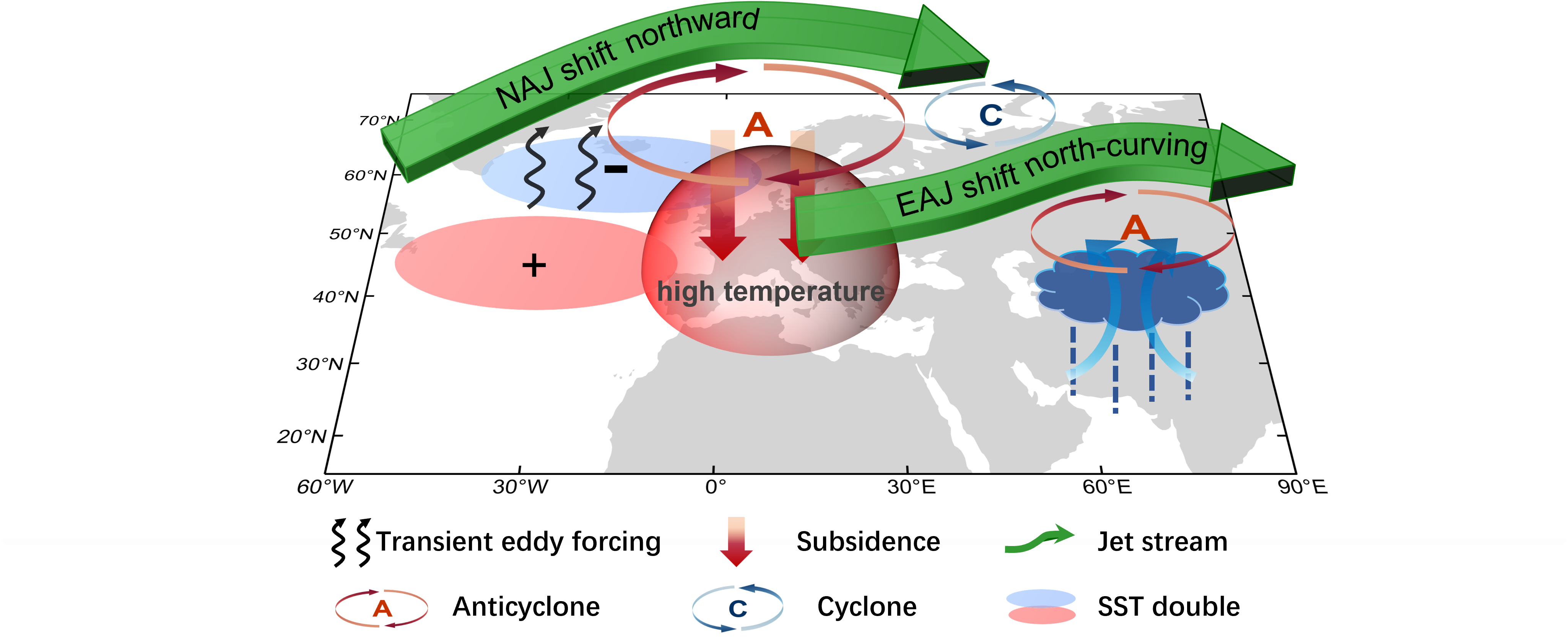Unveiling the Synergistic Impact of the North Atlantic Jet Stream and the Eurasian Jet Stream on the 2022 Record-Breaking Heat in Western Europe
Published in Earth & Environment

In July 2022, Western Europe experienced an extreme heat event that broke temperature records, with temperatures in Portugal and Spain even surpassing 46°C. The UK Met Office issuing the country's first-ever red warning for exceptional heat. The extreme temperatures, accompanied by heatwaves, drought, and wildfires, caused widespread impacts on both the natural environment and socio-economic systems, including crop failures, water shortages, and increased heat-related health risks.
Our research reveals that this unprecedented heat was linked to a unique configuration of the North Atlantic Jet Stream (NAJ) and the Eurasian Jet Stream (EAJ). Specifically, the NAJ shifted northeastward, while the EAJ curved northward over the northern Indian subcontinent. The northeastward shift of the NAJ facilitated an anomalous subsiding airflow and a high-pressure system over Western Europe. Meanwhile, the curvature of the EAJ, associated with a positive phase with the Circumglobal Teleconnection (CGT) pattern, also contributed to the formation of a high-pressure anomaly over the region. The combined effect of both jet streams resulted in an unusually strong high-pressure system over Western Europe, triggering the extreme temperatures observed in July 2022 (Figure 1).
Further research revealed that this unique jet stream configuration was influenced by the North Atlantic Dipole (NAD) sea surface temperature (SST) pattern and intense rainfall over Pakistan. The SST gradient in the North Atlantic helped strengthen and sustain the northeastward shift of the NAJ, contributing to the high-pressure anomaly over Western Europe. At the same time, while Pakistan’s rainfall was influenced by upstream wave train, the intense precipitation there generated atmospheric heating, which triggered westward-propagating Rossby waves, further enhancing the high-pressure anomaly over Western Europe. Both of these physical mechanisms were validated using the CAM 5.1 model.
Moreover, the study explored the impact of similar jet stream configurations on Western Europe’s temperatures under different forcing scenarios using the Sixth Coupled Model Intercomparison Project (CMIP6). Under the SSP245 and SSP585 scenarios, similar jet stream configurations are expected to raise Western European temperatures by 0.53±0.40°C and 1.56±0.61°C, respectively, in the latter half of this century. Notably, under the SSP585 scenario, temperatures in Western Europe could rise by an astonishing 7.02±0.61°C compared to current climatological mean, highlighting the growing threat of such extreme events in the context of global warming.
This research not only enhances our understanding of the mechanisms behind extreme heat events but also deepens our appreciation of the climatic effects of the North Atlantic SST gradient. It underscores the importance of not only focusing on average temperature changes in future climate scenarios but also paying attention to temperature variations under anomalous jet stream conditions. The findings contribute valuable insights for predicting future heat extremes in Western Europe and inform policymakers in addressing climate-related risks.

Figure 1. Conceptual diagram of the mechanism of the western European warm events in July 2022. The north Atlantic dipole-like SST pattern induces northeastward shifts in the North Atlantic jet stream (thick green arrow) via transient eddy forcing (black curved arrows). Rainfall in Pakistan contributes to the positive phase of the CGT pattern (A-C-A), causing the Eurasian jet stream to curve. The anomalous jet configuration induces positive Surface air temperature anomalies in western Europe by enhancing subsidence (red arrows).
Follow the Topic
-
npj Climate and Atmospheric Science

This journal is dedicated to publishing research on topics such as climate dynamics and variability, weather and climate prediction, climate change, weather extremes, air pollution, atmospheric chemistry, the hydrological cycle and atmosphere-ocean and -land interactions.
Related Collections
With Collections, you can get published faster and increase your visibility.
Understanding the Dynamics of Air Pollutant and Greenhouse Gas Emissions in a Changing Climate
Publishing Model: Open Access
Deadline: Dec 31, 2025
Modeling of Airborne Composition and Concentrations
Publishing Model: Open Access
Deadline: Mar 31, 2026





Please sign in or register for FREE
If you are a registered user on Research Communities by Springer Nature, please sign in